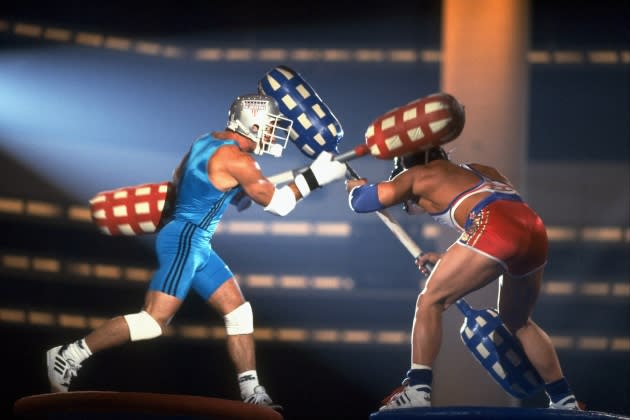The Dark Side of ‘American Gladiators’: Addiction and Exploitation

Johnny Ferraro comes across like a Mafia soldier in witness relocation as a used car salesman, or maybe that one casino employee you really don’t want to mess with. He has a way of looking at the camera like he wants to strangle it, or at least spit on it. But somehow, some way, he musters charm. Ferraro is the creator of the much-mocked, absurdly popular proto-reality-TV competition series American Gladiators. Or is he?
This question lingers over the new two-part ESPN 30 for 30 film The American Gladiators Documentary, whose simple title intentionally belies a story rife with irony and wickedly sharp turns that ends up interrogating the filmmaking process itself. Director Benjamin Berman turns what was widely derided as barbaric spectacle into fodder for postmodern tragicomedy. This is a witty, mischievous, inventive but ultimately quite sad work, a worthy entry in ESPN’s enduring and consistently intelligent doc series.
More from Rolling Stone
'The Ultimate Fighter' Livestream: How to Watch TUF 31: McGregor vs. Chandler Online
Celtics vs. Heat Livestream: How to Watch the NBA Eastern Conference Finals Online Free
IndyCar Livestream: How to Watch the NTT IndyCar Racing Season Online
Viewers of a certain age will remember Gladiators, which ran from 1989 to 1996 and was for a time the most popular syndicated series on television. Muscle-bound, spandex-clad specimens with comic book names — Nitro! Gemini! Zap! — competed with contestants in challenges that could scarcely be called sports. They jousted with pugil sticks. They rolled around in metal spheres, knocking each other silly. If it looked dangerous, it was. “Many of these games were not safe for humans to play,” one Gladiators producer says in the film, which makes clear that serious injuries were plentiful, as was pain pill addiction.
To which Ferraro tells Berman: “You can’t get glory unless you go through a little bit of pain.” There was no medical plan on American Gladiators, and financial compensation and job security were minimal. But steroids weren’t. Berman speaks with a handful of original Gladiators, fleshing out their identities not just as characters but as people; the two-part film conveys that they got a huge rush out of the experience, even if it made many of them wrecks when the show spit them back out into the real world. William Smith, or “Thunder” in Gladiator speak, is shown toiling on a North Carolina farm, clearly having difficulty walking. Two shows a day, six days a week will do that.
This human toll is one compelling element of The American Gladiators Documentary. But the bigger story focuses on the show’s origins, and on Ferraro’s efforts to keep Berman from discovering them. It all began far from Hollywood schmaltz and glitz, with a group of rugged ironworkers in Ferraro’s hometown of Erie, Pennsylvania. The original American Gladiators competition was held in 1982 in a high school gym and was apparently conceived by Ferraro’s friend, “Apache” Dann Carr, a mountain of a man who was accustomed to getting Ferraro, then an Elvis Presley impersonator, out of barroom trouble. The two friends hatched the idea for a showbiz version, after which Ferraro seems to have lawyered his old, blue-collar friend out of the money. One American Gladiators producer points out as bitter irony: The series, which was hatched during a WGA strike (though it premiered later), ended up expunging its hardcore union roots.
The first part of the documentary ends with the information that Ferraro now controls Carr’s public appearances in perpetuity and has no intention of letting Berman speak with him. This is when the film gets gleefully gonzo. Berman gets ahold of a self-published book written by Carr — the ironworker wrote with a vivid, expressive terseness — and gets a suitably massive actor to play Carr in reenactments. He visits Erie, where Carr is still held in high esteem. He goes searching for the man that his main subject really doesn’t want him talking to. And he takes every opportunity to remind us that we are watching a film, a work of artifice, as every film, even a documentary, inevitably is.
Berman plays the straight-faced prankster here, but he has crafted a fully alive piece of cinema, emotionally resonant and nostalgic even as it looks at nostalgia with a caustically raised eyebrow. The filmmaker knows he has a rich character in Ferraro, whose image frequently appears before a backdrop of the cosmos. This guy really does seem to think he is the center of the universe. Berman pokes. He gently prods. He gives Ferraro more than enough rope. But somehow The American Gladiators Documentary never really judges. It acknowledges and respects human fallibility, and even ends on a positive note. The film walks several tricky lines but never falls flat. To put it in Gladiator terms, Berman would have made a first-rate jouster.
Best of Rolling Stone
